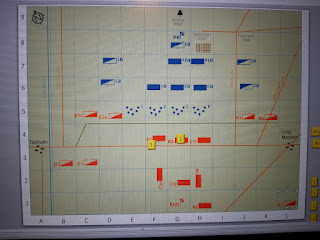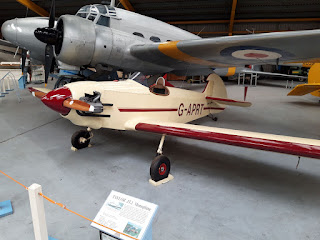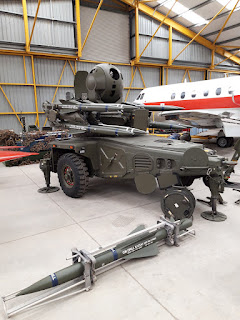Taking advantage of the recent good weather, Tim organised a trip to Newark Air Museum with him, myself and Diego. It wasn't even a museum I knew existed, despite having gone to Partizan next door for years! I think the planes are hidden from view from the wargames show by the car auction site in between.
Anyway, the museum is quite small but packs in tons of stuff (mainly Cold War era jets) and is very reasonably priced to visit.
Wooo! A beautful Vulcan. As I've often remarked, these used to fly low over out house in the 1960s, en route to and from RAF Woodford near Manchester.
And some payload. In front a Yellow Sun H Bomb, with a rather measly yield of 500kt, and behind a Blue Steel standoff missile which I can still recall hanging off the bottom of the planes.
The collection boasts no less than three Canberras. This one has rather an ugly extended nose cone.
A Shackleton, these used to fly over the house too. What a fab planes, I do like the contra rotating props.
A Hastings transport plane. Amazingly this huge plane has a tail wheel.
Dassult Mystere IV
A slightly tatty Puma under restoration.
And a beautiful Buccaneer. A huge aircraft, how it ever landed on a carrier is beyond me.
There are two main aircraft sheds and one smaller engine shed. The larger sheds are stuffed with real planes and lots of models. These are all 1/144th scale WW2 bombers.
A Saab Draken.
A a Taylor JT1 micro plane. It is so small it is almost a scale model. The museum had a number of micro planes, including a Flying Flea. This one does at least look fairly air worthy.
An Avro Anson is behind, so you can see how small the Taylor is
This is a LINK D2 Trainer for instrument flying training. The whole thing is mounted on a sort of hydraulic platform.
RAF WW2 Bomber memorial. Large scale models of the main types and bits of real planes on the adjacent display.
A section of tail from a WW1 Pfalz.
And a prototype Bouncing Bomb, this one recovered from the test range at Reculver.
There was a lovely reproduction of an Anderson Shelter outside, complete with a small shelter for the hens.
Another pointy nosed Canberra, this time in an exciting all black colour scheme. This example used to fly out of Boscombe Down doing hush hush things
A beautifully restored Lightning trainer. The top of the fuselage has been widened to take a two seater cockpit, hence the slight Bulge which is visible.
A Hunter in need of a bit of TLC. When my father was in the RAF he was stationed at West Raynham, a Hunter station.
And a lovely Gannett.
A restored Meteor night fighter trainer. Possibly the ugliest plane in the collection! The double extended nose (radar dome and back-back two seater cockpit) just looks very odd. There was also one of these at RAF West Raynham, which my father said was used as a liaison plane. Sadly it crashed on a mission flying a spare part to a grounded Hunter, killing both the pilot and engineer.
A Lockheed F-80 clone, a T33, supplied to the French Air Force as military aid. This one is in very jazzy USAF colours.
A very well restored Mig 27 'Flogger'.
A Bloodhound and control vehicles. Awaiting restoration.
A Sea Harrier.
Gloster Javelin. This plane is huge! These also operated out of West Raynham (in fact this particular plane was stationed there). My father recalls one going into a flat stall and crashing after performing illegal low level aerobatics. "A dreadful plane" was his verdict.
Saab Viggen in jazzy Swedish camo.
There is a section on the evolution of aerial navigation. One of the items featured was a Slide Rule, which I do dimly remember how to use, however this one is in Russian!
The Sea Harrier again. What a lunatic decision to scrap these.
Supermarine Swift and Hawker Hunter side by side.
Another night fighter Meteor. The special types were later replaced by general purpose aircraft.
RAF armament down the decades. Fromt top to bottom: Browning .30 cal, Browning .50 cal, Polsten 20mm, Rarden 30mm.
Rapier towed AA system.
The Buccaneer from the other side.
Zpu towed AA gun.
A Bristol Hercules engine in the engine shed. This powered a wide range of types including the Wellington, Stirling, Halifax and Beaufighter.
A standard Meteor parked next to a standard Canberra.
Another view of Blue Steel and Vulcan.
Westland Wessex in need of some attention (there is a much neater one in Air Sea Rescue colours in one of the sheds).
A missile armed wheelbarrow(!).
That was a great day out, highly recommended if you are in the area.































































